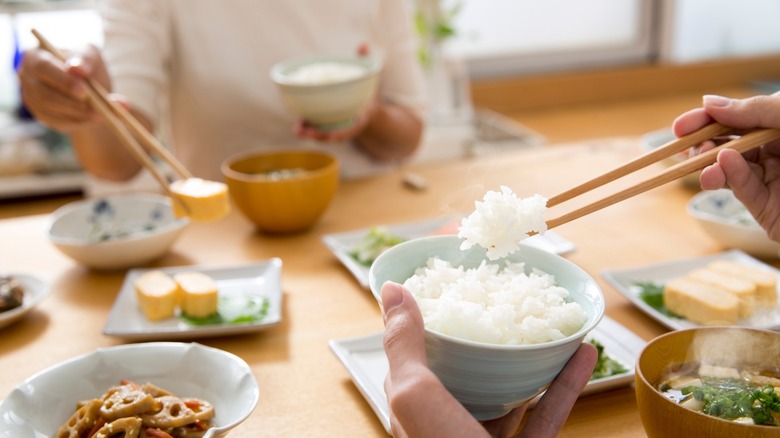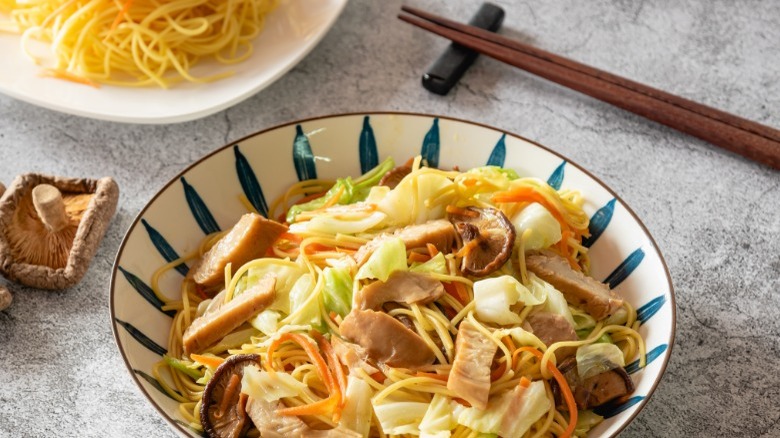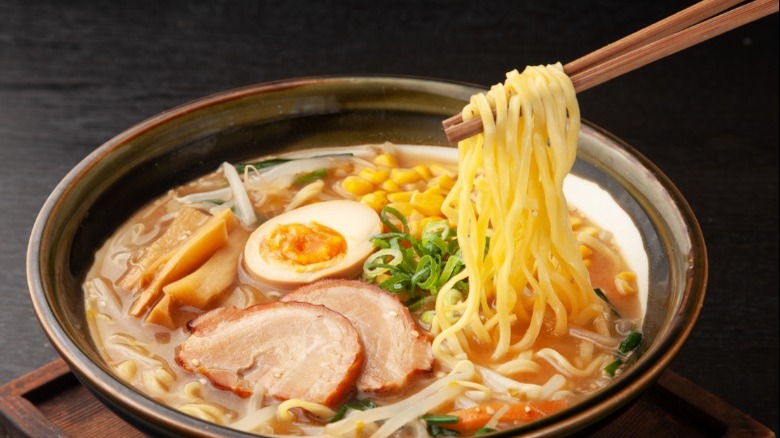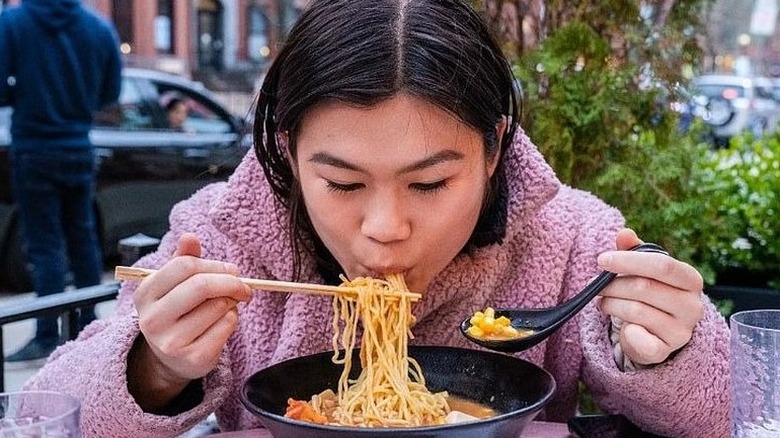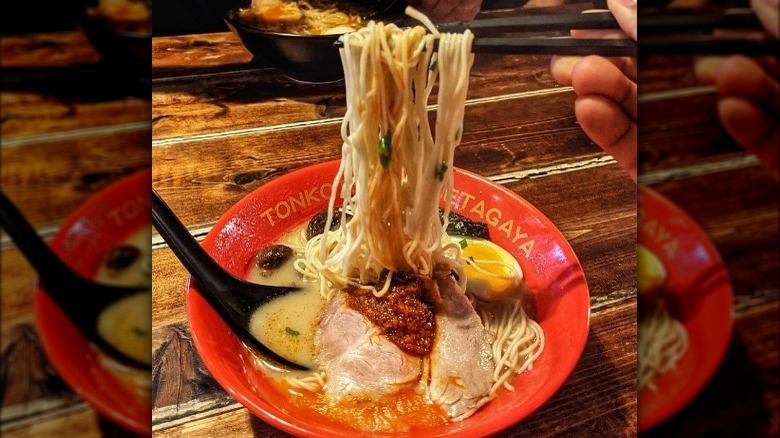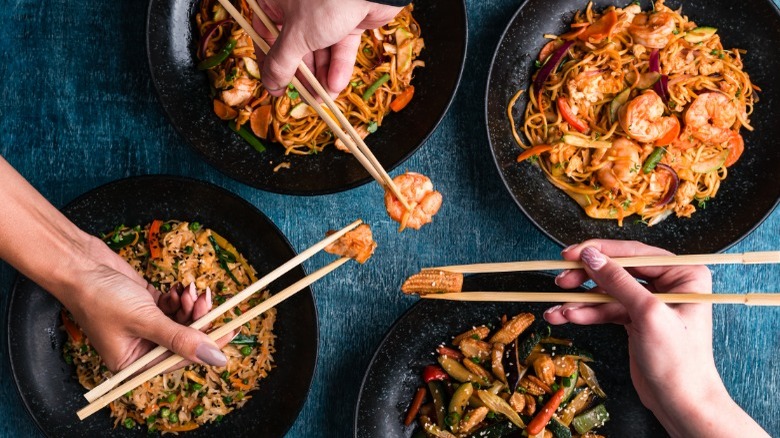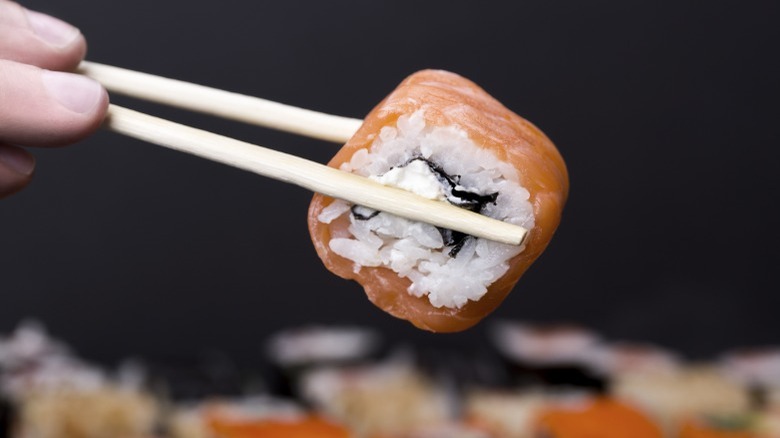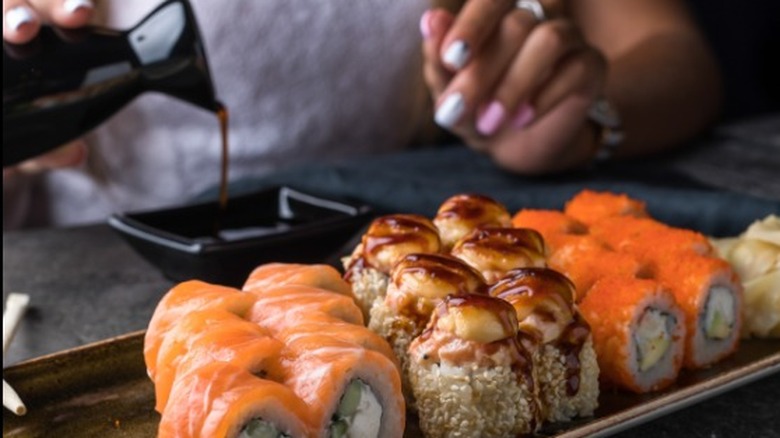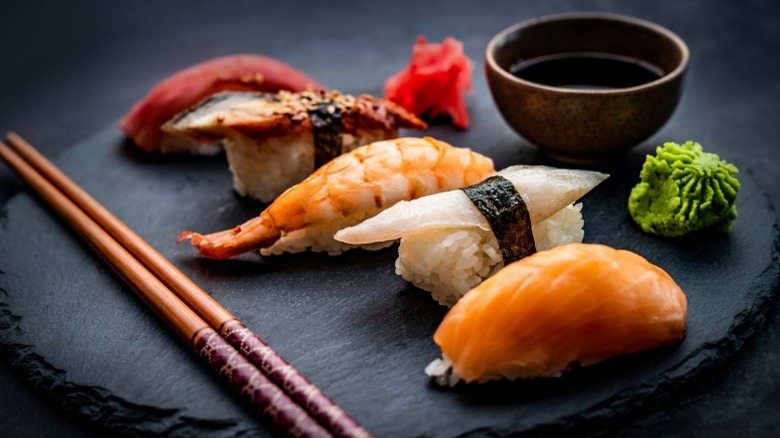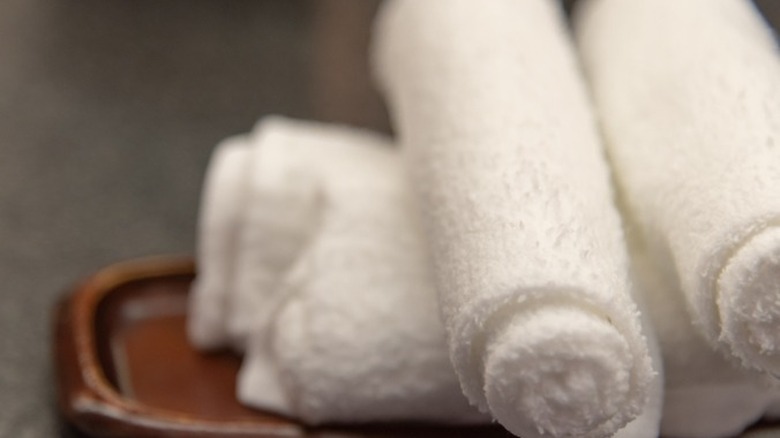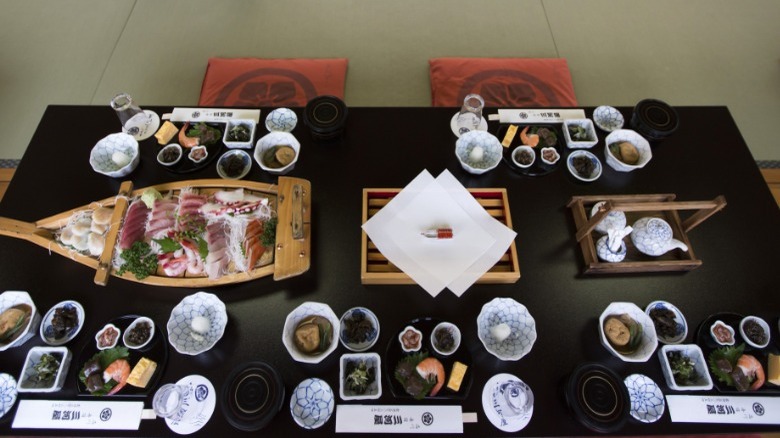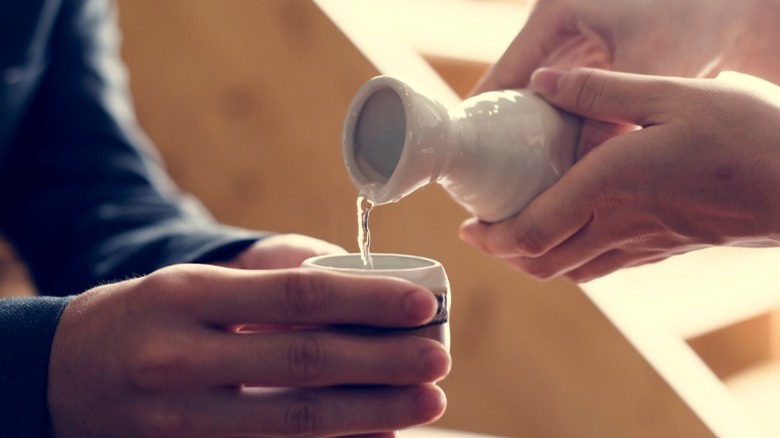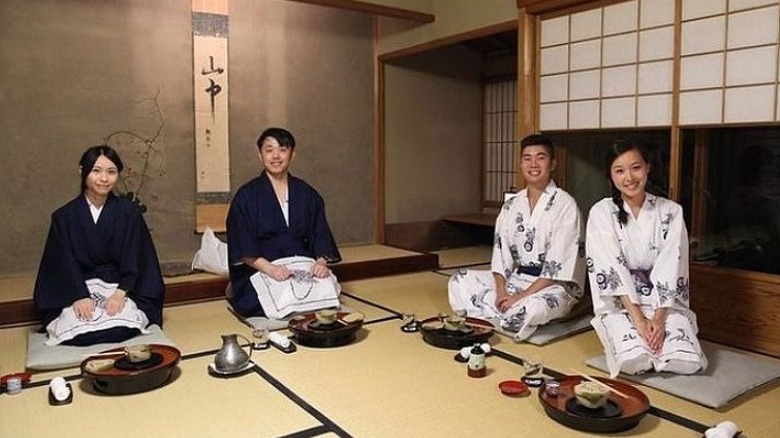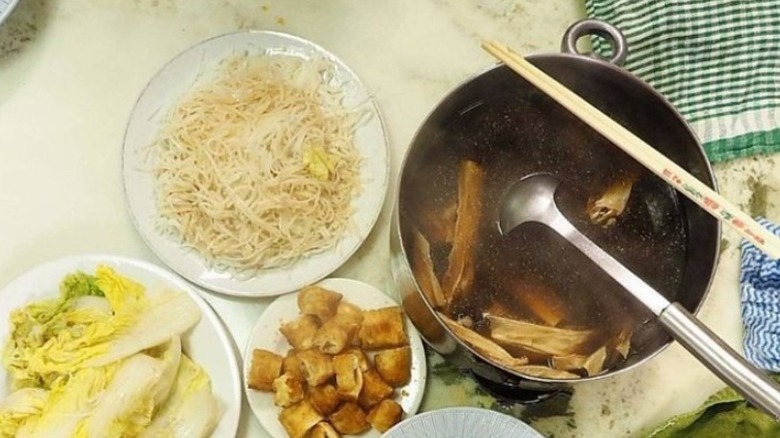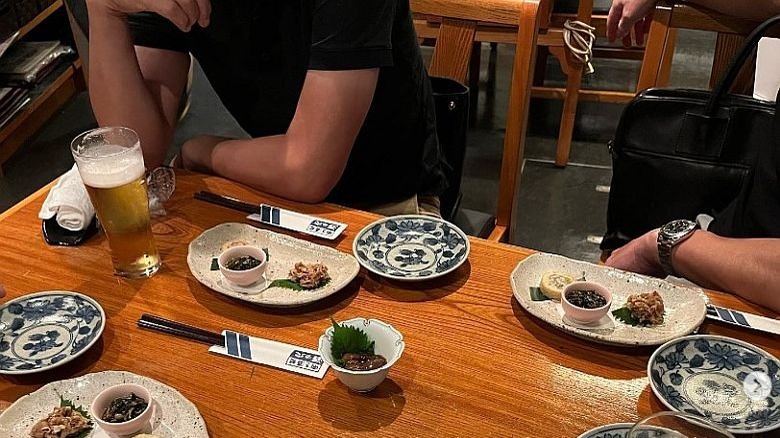15 Japanese Eating Etiquette Rules You Need To Know
Planning a trip to the land of the rising sun? Japan's rich history means there are plenty of traditional eating customs and etiquette you might be unaware of before your trip. Whether you're dining at your ryokan, at a restaurant, or in somebody's home, you're sure to find yourself asking many of the following questions.
Where should you rest your chopsticks? How much soy sauce should you pour? What is an oshibori? Though you don't need to be overly concerned about table manners when visiting Japan, as most Japanese people will be more than happy to teach you, it's helpful and polite to be aware of some basic customs. Whether you're heading for the bright lights of Tokyo, touring temples in Kyoto, or unwinding in an onsen town, we'll answer all these questions and more. Here are 15 Japanese eating etiquette rules you need to know for your next visit to Japan.
1. Don't rest your chopsticks on your bowl
There are plenty of rules relating to eating with chopsticks in Japanese culture. However, one of the most important rules to remember when dining in Japan is that you should never rest your chopsticks on your bowl. If you're pausing between bites or need to place your chopsticks down, use the provided chopstick rest.
If a chopstick rest hasn't been provided, you can make your own one using the chopstick wrapper. Alternatively, you could always rest your chopsticks on a tray or similar dish on the table, but you shouldn't rest them on your bowl.
Placing your chopsticks across your bowl signals to those you're dining with, and the chef, that you are finished eating. This could be considered rude if you are still eating and there's food remaining in your bowl. Similarly, you should never leave chopsticks sticking straight up in your bowl. This is thought to bring bad luck, and it's considered poor etiquette.
2. Use chopsticks to eat your soup
We know what you're thinking: "How do I eat my soup with chopsticks?" While you can use a spoon to slurp up the delicious broth from your soup, it's customary to use your chopsticks to eat solid items such as vegetables, meat, beansprouts, or dumplings.
Remember to hold your chopsticks properly and use them to scoop up items from your soup. You can hold the bowl up to your face if you find it easier to move items from your bowl to your mouth by doing so. However, Don't use your chopsticks to spear food.
Once you've consumed more oversized solid items in your soup, you can bring the bowl to your mouth and slurp the remaining broth directly. You can also use a soup spoon, if you prefer — though as you're about to see, slurping is actually a good thing in Japan, and actively encouraged.
3. Slurping is a must and signals appreciation
Did your parents teach you that slurping is rude? That's a common thing in Western countries: Kids are routinely taught that we shouldn't slurp our soup, noodles, or juice at the table.
In Japan, you can throw the slurping rulebook out the window! Slurping is a way of life, and it's practically mandatory if you want to make a good impression at dinner — whether you're dining in somebody's home or in a restaurant. In fact, slurping your noodles or soup is a sign of appreciation, showing that you're actively enjoying your food. As well as reassuring your hosts (or restaurant staff) that your dish is going down well, slurping is thought to enhance the flavor of dishes.
Still not sure about slurping? It has the added bonus of cooling down your noodles, so there's less risk you'll burn your tongue on that steaming hot bowl of miso ramen.
4. Don't linger over ramen
If you're eating at a ramen-ya, the idea is to get in, enjoy your ramen, and get out. Most people there won't linger for hours, holding lengthy conversations and occupying tables. City workers often head to ramen shops for a fast, convenient, and tasty lunch. Speed is key! Smaller shops with limited tables fill up quickly, so while you can chat with your friends, concentrate on eating.
The ordering process in ramen shops moves fast, too. Check out the menu and decide what you want before entering the shop. There's often a ticket machine for orders, so make your decision before you put money in the machine to avoid irritating those queuing behind you.
Using chopsticks is recommended at ramen-ya shops. However, don't be afraid to ask for a fork if you're struggling — nobody will judge you — and the dish will taste just as tasty!
5. Don't stab your food with chopsticks
This is a big no-no. Stabbing your food with your chopsticks is considered a serious etiquette crime – not just in Japan but across Asia. Chopsticks aren't all that difficult to master, and you can practice at home if you're struggling. If you get really stuck, nobody will mind if you ask for a fork.
Eating noodles? Hold your bowl up to your face, using the chopsticks to guide a stream of noodles into your mouth. Don't be afraid to slurp up those saucy noodles, as this shows you appreciate your food. Yes, it can be a little tricky using chopsticks to eat rice. Rather than trying to pick up rice between your chopsticks, use them together like a scoop, holding the bowl near your face. The closer the bowl is to your face, the less likely you'll end up with rice all over yourself and the table.
When you've finished — or when you're pausing for a drink or to chat — remember not to rest your chopsticks on your bowl. Place them on the chopstick rest or on another dish at the table.
6. Eat your sushi in one bite
Eating "beautifully" is an important thing in Japan. Sushi is a visual feast, with the finest sushi chefs spending hours handcrafting the perfect sushi rolls for your enjoyment. Generally, sushi is meant to be consumed in one bite. With maki sushi, dip your roll into the soy on the seaweed side. When it comes to nigiri sushi, dip the fish side into the soy, not the rice side. Using chopsticks or your hands is acceptable, so choose whichever you find easiest.
However, nobody will judge you if you can't fit an entire sushi roll into your mouth in one bite. You might find this happens if you're eating particularly large or decorative sushi rolls with lots of toppings. If you need to take two bites, do so cleanly, and don't let the sushi rice fall apart into your soy sauce. This brings us nicely to the next point on our list. It's a really important one, too!
7. Never pour too much soy sauce
Though it's not an expensive ingredient, wasting soy sauce is a cultural no-no — signaling bad manners. When pouring soy sauce into a provided dish, pour just a little. If you need more sauce, you can always go back for more.
Many sushi rolls, such as maki, are designed to be dipped into soy. This adds a rich, salty, umami flavor that complements the fish, meat, eggs, rice, and seaweed. However, you'll find some more elaborate sushi rolls have already been marinated, so you don't need to dip these in soy sauce. Again, you can avoid adding more soy to pre-drizzled rolls to enjoy the flavors the chef intended.
When dipping your sushi into soy sauce, remember not to soak the rice in soy. This is particularly important with nigiri: You should always dip the fish side down into the sauce before eating it.
8. Don't mix wasabi with your soy sauce
If you've dined in a sushi restaurant in the U.S., you've probably witnessed friends or other diners mixing wasabi into their soy sauce. In modern-day Japan, it's considered acceptable to mix a small amount of wasabi into your soy sauce.
However, the traditional custom is to place a little wasabi on your plate instead. This is generally thought to be because adding the wasabi to the soy sauce turns it into an unappetizing green color. It's also difficult to judge how much wasabi to add to your soy. Adding too much could result in your soy sauce becoming too spicy to eat, meaning you may end up wasting it. As we mentioned earlier, wasting soy sauce is considered bad manners across Japan. Try to remember this rule if you can. But don't worry too much if you forget and mix a small amount into the sauce.
9. Clean your hands with oshibori before eating
If you've dined in a Japanese restaurant before, the rolled oshibori — or wet towels — provided will be a common sight. These towels are offered to diners in most restaurants, allowing you to clean your hands before your meal starts. However, it's important to note that your oshibori is for your hands, not your face. You may see some Japanese people using their towel to wipe their faces, but it's generally considered poor etiquette.
If you absolutely must wipe your face, for whatever reason, do that first, then use the towel to clean your hands. Once you've finished, remember to fold or roll your towel — never scrunch it up or toss it back onto the table unfolded.
In restaurants where there are no towels provided, it's acceptable to excuse yourself to wash your hands before the meal starts. Alternatively, you could carry a small pack of wet wipes or hand sanitizer to use discreetly at the table.
10. Return your dishes to how they were when you finish eating
You've used your oshibori correctly, handled chopstick etiquette perfectly, poured yourself just the right amount of soy sauce, and remembered to slurp your noodles to show appreciation for your food. Surely that's all there is to dining in Japan, right?
What happens once you've finished eating is just as important as your conduct during the meal. When you've finished dining, return all your dishes to their original position on the table. Most Japanese meals consist of many small dishes, so not only does this leave the table looking tidy, but it also makes life easier for your server or host. You should also ensure you place lids back on pots and rest your chopsticks back on their holder.
If you're dining at the house of a Japanese person you're close to, this will usually be a less formal meal, so there's no need to worry as much about this custom. If you remember though, it's still considered polite and respectful to do so.
11. When drinking alcohol, pour others' drinks before your own
When drinking alcohol in Japan, it's customary to pour drinks for others before serving yourself. You should take the bottle and pour a drink for everyone else first. Let somebody else pour for you. Japanese people are also very attentive during the meal and will refill others' glasses after every few sips, so you should feel free to do the same. It's also important to remember that you shouldn't start drinking until everybody at the table has had a drink poured.
After everyone has a drink, glasses will usually be raised for a cheer, which in Japanese is: "Kampai!" Of course, if other diners are drinking bottled beer or a glass of wine, you won't need to worry about this rule. But it's a handy one to know, as you'll need it if you're drinking sake or sharing a bottle of wine.
12. Don't blow your nose or burp at the table
Blowing your nose or burping at the table isn't seen as polite in many cultures — not to mention it's not pleasant for those you're dining with to witness. In Japan, it's considered particularly rude, as the Japanese are extremely polite and hygiene-conscious. Nobody wants your germs in the air or all over their food!
When dining in Japan, it's also important to pay attention to how you eat. Even a quiet audible burp is considered impolite. Loudly munching on or chewing your food is a huge no-no. We understand that there are times you might need to blow your nose — for example, if you're sick. Though it's better to avoid dining in restaurants if this is the case. If you do have to blow your nose, always excuse yourself from the table and go to the restroom to do it out of sight from your dinner guests.
13. Always remove your shoes or slippers before stepping on tatami
In some restaurants, you'll find a traditional tatami floor instead of tables and chairs. There's only one rule to remember when stepping on tatami: Always take off your shoes or slippers. You should never, ever step on the tatami in shoes or slippers. Even if your footwear isn't dirty, this is considered unclean and disrespectful.
When it comes to tatami etiquette, it's formal to kneel (seiza), but this can be uncomfortable for many people. Most Japanese people won't expect visitors to kneel in this position for long. Alternatively, men can sit cross-legged while women should sit with both legs to one side.
As with anything in Japan, if you're dining with Japanese friends or business partners, don't be afraid to ask about anything you're unsure of doing. Nobody will judge you, and it's considered much more respectful to ask than to assume and get things wrong.
14. Don't use your own chopsticks for communal dishes
Many Japanese meals consist of a variety of communal dishes. You serve yourself, but you should never use your own chopsticks to do so. You may find dedicated serving chopsticks provided next to — or resting on top of — hotpots or other shared dishes. You can use these chopsticks to move food to your own bowl.
Don't panic if there aren't any dedicated chopsticks for serving. You can always use the opposite end of your chopsticks to serve yourself from communal dishes. If you feel uncertain about the appropriate etiquette when sharing dishes, just watch those around you to see what they do. This is a good rule of thumb for anything you're unsure of when dining in Japan, whether eating at a restaurant, at a friend's house, or at the home of a business colleague or partner. If all else fails, just ask!
15. Pay attention to seating arrangements
Though you're less likely to encounter this situation in restaurants, if you're enjoying a special meal at the home of a Japanese person, or attending a business dinner or other formal event, seating arrangements need to be carefully considered. The middle of the table — kamiza, or the "top seat" — is considered the most honored position at the table.
This tradition is rooted in feudal Japan, at a time when the safest position was considered to be the one furthest from the door. Generally, it's also the warmest seat. The host will always be seated at the middle of the table, with the honored guest in the middle on the other side, farthest from the door, and directly opposite the host. This position is known as shimoza.
While learning about traditional Japanese seating arrangements is interesting, don't worry too much about this. Your hosts or business partners will direct you to where you should sit.
